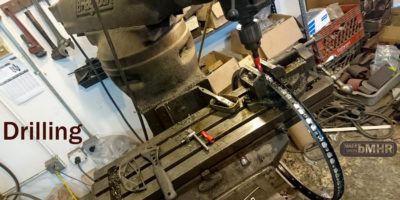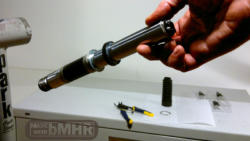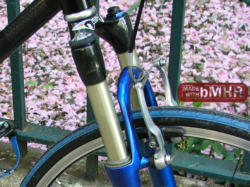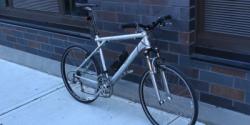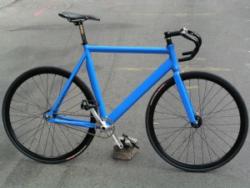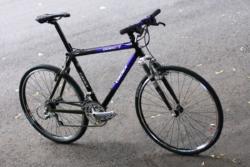Wide Rim Weight Reduction Experiment.
For Acceleration Improvement.
by Brian Miller, citizen scientist.
CONCLUSION:
Worthwhile.
For the environment of paved city street riding, improved deceleration, acceleration, and steering speed are rather beneficial; lighter rim is better.
ABSTRACT:
An unusually wide bicycle rim is needed for a high performance urban bicycle project. To improve acceleration and deceleration of this wide hunk, the outermost-possible diameter needs to be lightened. To minimize loss of strength, circular holes of material are removed from the inner wall of the rim.
Two wheels are built with identical components except that one rim has holes drilled through it. The wheels are even aerodynamically identical.
The extremely low budget for this experiment was still good enough to show results. Tested side by side, the drilled rim, is 7.1% lighter, and accelerates 8.9% quicker than the solid rim.
The fundamentals of this design can be used with other rim material, especially when molding carbon fiber; periodic weight reducing openings, or even varying thickness material, will increase acceleration while maintaining strength.
Though the increase is small, and there are advantages to both heavy rotating mass and light rotating mass1, it is up to the individual rider to determine if the construction effort is worthwhile to gain some improvement with acceleration and deceleration.
1 A wheel with light rotating mass accelerates, decelerates, and changes direction quicker; but requires constant steady power to maintain maximum speed. A wheel with heavier rotating mass needs more effort to get it up to speed; but its momentum coasts easier, maintaining a maximum (though lower) speed with less effort.
INTRODUCTION:
By reducing the mass of anything, you will be able to push it easier. The mass of a rotating body is easier to turn when it weighs less. The weight out at the outermost diameter is extra important for this force because there is more mass of material to make the circle, and it is moving the fastest.
The cause of this experiment is the need for an unusually wide rim, to reduce tire lateral flexing by making the tire beads farther apart. Available wide rims are for off-road, heavy impact and stunts; these are overbuilt for pavement riding, they can have material removed without losing too much strength.
The main concept here maybe seems obvious, and can probably be demonstrated with calculus, but here is a real world physical demonstration for your entertainment.
A metal cutting tool was researched and procured. A Bridgeport mill was located and scheduled; rpm speed calculated for tool and material, and set by master machinist John McDevitt of McDevitt Metal. Then yours truly stood around all day moving a giant machine head, making a hole, rotating rim, move giant head, drill hole, rotate rim, move giant head, …
WHEEL COMPONENTS AS TESTED:
Wider than ordinary rims by 5.5mm – Sun Rhyno Lite rim, double wall, welded butt, with steel spoke eyelets, machined sidewalls, and presta valve diameter hole; 26”, 559×27, measures 27.5 mm wide. 32 double butted stainless steel spokes, aluminum alloy nipples, Shimano Deore hubs.
The Rhyno Lite, by Sun, is used because it is already pretty light for its width, strong, and inexpensive. Drilled holes became the chosen lightening method because it was possible, and the round holes do not provide a start for stress cracks, the round edges retain much of the strength of the material, kind of like Roman arches in compression.
WEIGHT RESULTS:
Solid rim – 574 grams, Drilled rim – 533 grams. 41 grams are removed. The stock solid rim lost 7.1% of its weight, at the farthest diameter.
To function in the wild, the rims will need rim strips to protect the inflated inner tube inside the tire. The Drilled rim uses layers of wide woven fiber tape. The Solid rim uses a conventional plastic high performance rim strip. The remainder of the wheel construction is identical. Finished wheel weights: Solid – 1168 grams, Drilled – 1100 grams. So, considering the wheel assembly, the drilled rim is 11.8% lighter.
MEASUREMENT DEVICES:
Three slow motion video cameras: a GoPro at 480 fps, another sport camera at 720 fps, and a Google Pixel 2 phone camera with 240 fps (frames per second). Nexus 6P phone with Stopwatch Ultra stopwatch app. A Sigma brand bicycle speedometer. To improve the “resolution” of the speedometer, 4 pickup magnets were used instead of 1.
Even with the improvement of the speedometer, the damn thing took too long to give its first reading. Then, it was determined that the number of spokes passing in 1 second can be observed and compared between the two rim types. Of the 50 or so runs, the top 2 fastest runs are used, and averaged.
TIMING RESULTS:
Measurements of the number of spaces on the rim, between spokes,
that pass a stationary point, during the first one second:
The two fastest and most consistent of the runs were used, and averaged.
Solid rim, video number 155133 –
Run B – starting at 0:16.90 seconds until 0:17.90 seconds – 50.2 spokes
Run C – starting at 0:32.87 seconds until 0:33.87 seconds – 50.3 spokes
average – 50.25
Drilled rim, video number 161638 –
Run F – starting at 2:03.93 seconds, until 2:04.93 seconds – 54.8 spokes
Run G – starting at 2:27.00 seconds, until 2:28.00 seconds – 54.6 spokes
average – 54.7
(View the boring data videos here:
https://www.dropbox.com/sh/ngr7sdc44r9qjbr/AAB1P2Nx1TvJXeWLu5_uTx7na?dl=0 )
Watch the action-packed good summary video here:
https://www.dropbox.com/s/w6j8ct2nsse5j0x/rim-times-tested-light-bicycle-wheel-acceleration-made-with-bMHR.mp4?dl=0
